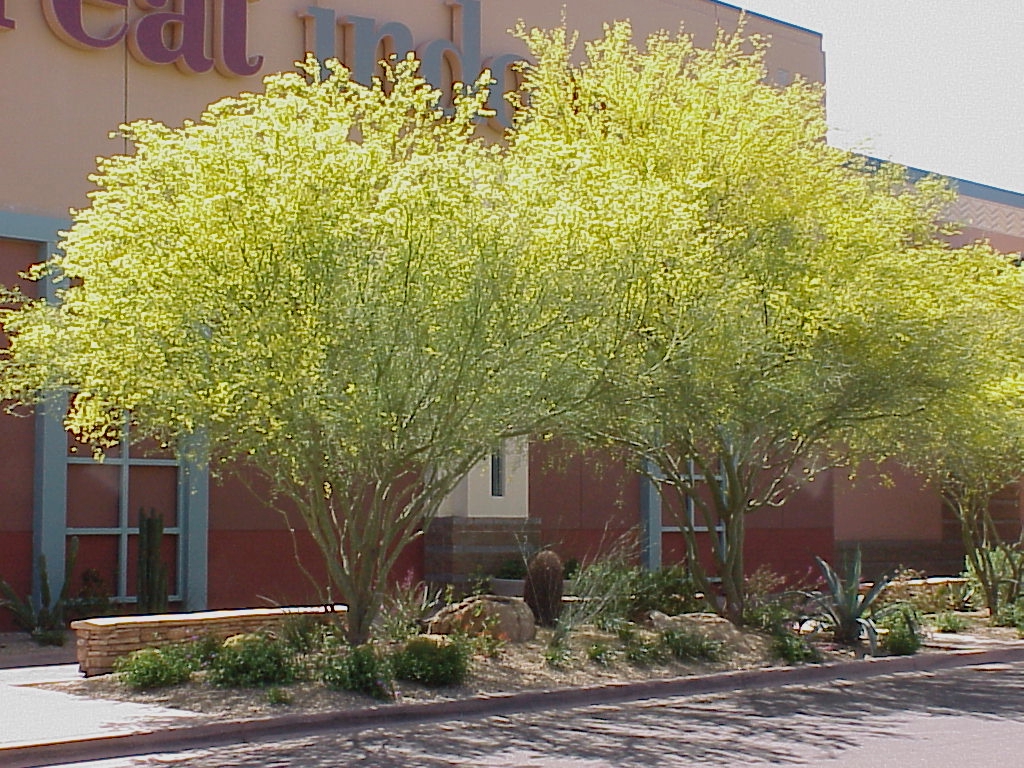


Cercidium floridum
(Parkinsonia florida)
Blue Palo Verde
Foliage: Deciduous
Mature Height: 20’ - 35’
Mature Width: 20’ - 35’
Growth Rate: Moderate
Hardiness: 10 degrees F
Exposure: Full Sun
Leaf Color: Green to Pale Blue-Green
Shade: Filtered
Flower Color: Yellow
Flower Shape: Funnel Shaped Petals
Flower Season: Spring
Thorns: Yes
Propagation Method: Seed
Sizes Available: #25, #45, & 48"




For year-round beauty and sheer volume of spring color, few desert-adapted trees can rival the Blue Palo Verde, Cercidium floridum. Blue-green bark, smooth on younger branches but becoming more grayish and fissured as trees mature, gives color to the graceful trunks and highly divided branches while providing a dark green backdrop for the intense yellow spring flower display. Flowers first appear in early spring and may persist into early summer. In mature, vigorous specimens, flowers literally cover the leaf canopy, creating masses of yellow in the landscape or dotting desert hillsides. When properly pruned, the trees reveal the color, texture and sculptural qualities of their trunks. The canopy is made up of finely divided branches armed with small thorns, and compound leaves with 5 to 10 tiny leaflets.
Blue Palo Verde is native to the American southwest and northern Mexico (including Baja California) and is widely distributed across this range from sea level to four thousand feet. This species is highly adapted to desert conditions, tolerating high summer temperatures, and is cold hardy to 10 to 15 degrees. It is found naturally along desert washes and on hillsides where soils are reasonably developed and where some summer soil moisture is available. In native settings Blue Palo Verdes grow as large shrubs, 25' to 35' tall and as wide.
Its uses include: as single large specimens or small groupings as a landscape focal point; at project entries; near monuments or signs; or at tee boxes, greens and along fairways in golf courses. Its desert form and character make it ideal as a transition tree between landscaped areas and undisturbed desert or as a theme tree in large landscape designs. They are also use in streetscape and perimeter planting in commercial, residential and municipal landscapes.
Cultural Practices:
Foster the development of a more dispersed root system and reduce the risk of wind throw by arranging irrigation emitters at varying distances from the trunk to encourage roots to "seek out" water and nutrients. Irrigation emitter arrangement along with other information on irrigations practices for desert trees can be found at Irrigation Practices for Desert Trees.
Prune as needed to reinforce the structure and form of the tree. Periodic thinning is the most desirable method of pruning. Avoid hedging or heading back desert species, as this will only stimulate excessive branching. Do not remove more than 30% of the canopy during the summer as this can lead to sunburn injuries that can later be invaded by wood boring insects. Always use clean, sharp tools that are cleaned regularly in a 10% solution of bleach. For detail pruning guide see Pruning Desert Trees.
Periodically insect pests can be a problem on some desert trees. On young trees, insect infestation can slow typical seasonal growth. Inspect trees during the growing season for common garden sucking insects such as aphids, thrip, whiteflies or psyllids. During dry months, (May and June) in dusty conditions, spider mites can appear. Monitor for infestation and apply controls as needed. Spray applications of water or water and Safer Soap give short-term control (3 to 7 days) for small insect population. For heavy infestation or longer control use federally registered insecticides. A contact insecticide application will kill existing adults. An application with a systemic soil drench will provide 8 to 12 weeks control for any post application insect hatchings or migration of insects. Before using pesticide for the first time or on new plants or cultivar, treat a few plants and check for phytotoxicty. Always read label and follow label instruction before using pesticides. For pesticide control recommendations contact a licensed pest control advisor.

© Copyright 2000-2020 Arid Zone Trees